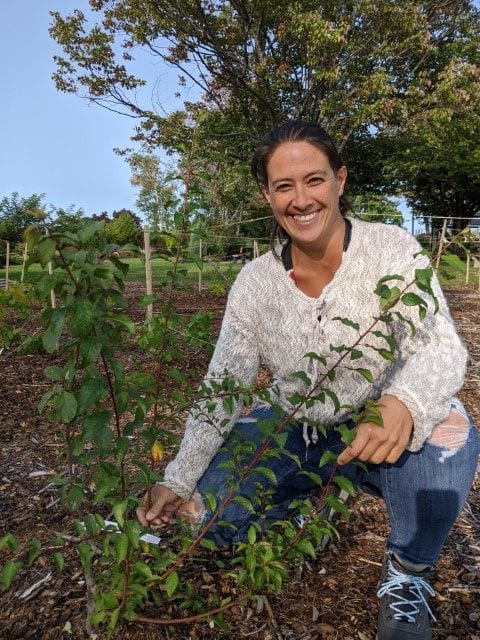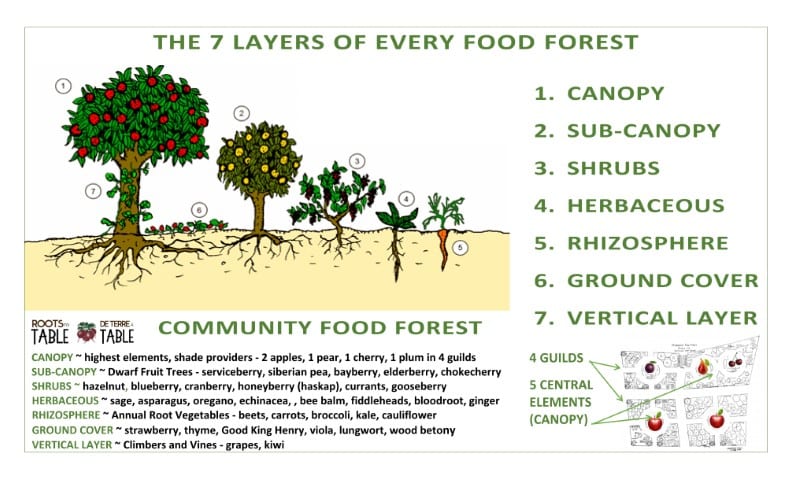Creating a Food Forest?… Say what?

specialist, inspects a plum tree in the Roots
to Table Community Food Forest at Mount
Saint Joseph.
By Terri Cormier, Roots to Table Regional Good Food Collective
With an ongoing global pandemic, there is no better time to start looking at our food not only as our energy provider but also as medicine. The first and best line of defence is a healthy immune system, boosted by healthy food.
With our climate’s short growing season here in NB, it can be challenging to find and eat fresh food. We export almost 95% of the food we produce and use only 11 percent of our available farmland. Statistics show that 11% of Northumberland county’s residents live in moderate to severe food insecurity; (Miramichi Area’s Community Health Needs Assessment, 2015). We can do a lot better than that and a food forest is a fun and interesting way to pay attention to what and how we eat!
Food forests belong to a field of agriculture known as permaculture. The word is a contraction of permanent and agriculture. Permaculture is a living-in-harmony approach to nature with a technical approach for how to do so. Along with community gardens and farmers markets, community food forests are a unique way to create access to nutritious food while helping our environment regenerate and maintain itself, without us humans getting involved.
What is a Food Forest?
By design, food forests are gardens, but become a miniature self-regenerating system of edible and medicinal plants.
It is an outdoor nature classroom, a public learning space created and used by local residents and neighbourhood associations. A perfect place to grow and show regenerative, organic and innovative growing methods native to our region’s climate. The idea is to integrate permaculture design with the traditional ecological knowledge and wisdom of our Native communities. They draw from permaculture, agriculture, ecology, biology and other natural living sciences, creating a living set of tools and practices that can help us engage in regenerative garden designs of all sizes and specialties.
Why Here?
The Community Food Forest is a five-year project of Roots to Table, Northumberland’s Good Food Collective, in collaboration with Mount Saint Joseph. With an already established public gardens, both sensory and vegetable, Mount Saint Joseph is the perfect spot to begin and grow the five-year plan which will eventually include Native American medicinal plants as well as a pond and beehive. With the Mount now transitioning into a center of community wellness, it was obvious that the site would be an ideal place for a demonstration food forest and community gathering space. They are especially suited for urban environments such as our city.
There are three more food forests about to begin as well – in Miramichi West, Douglastown and Blackville. More to come on those soon!

What’s Planted Here?
Every food forest has at least seven layers (see diagram) and many now include two more, water and fungi life systems which are often also within the permaculture of the forest. Our food forest has four guilds, or plant groups that work together to achieve the common goal of life and resilience. Each is designed around a central element such as a cherry or plum tree. From there, specific plant groups are strategically placed with attention to sun and wind orientation, existing environment and future growth.
Who Cares For It?
Volunteers. Roots to Table is a provincially supported volunteer network of people and organizations interested in good local food for the people of Northumberland County. We are growers, consumers, educators, practitioners, chefs, parents, grandparents, community leaders and followers, all working to elevate the access to a good local-first food experience in our region.
Bénédicte Donval, M.Sc – Ecology and Biodiversity Management, has joined the Roots to Table team as a consultant helping to develop the food forest.
Benedicte brings a wealth of knowledge to the table as an agro-forester and permaculturist – a specialist of nature and working with it. She and her family recently purchased an ‘urban farm’ here in Miramichi, where she is beginning her own food forest/research site for cold climate food production.
Roots to Table also offers programs and services such as Fresh for Less healthy food access program and we welcome new faces and invite everyone to participate in our Volunteer Program.
Who Pays For It?
The $30,000 project was started with $30,000 in funding from NB Environmental Trust Fund and a City of Miramichi Neighbourhood Matching Grant. We are seeking an additional $1000 to complete this year’s plant and are developing a Donation/Memorial program to welcome donations of the needed plants from anyone interested in learning and growing with the Food Forest.
What’s Next?
Immediate plans are to complete the final Fall plant, winter preparation and snow protection and planning the next phase for Spring 2021.
To learn more, donate, or volunteer, follow us on Facebook at /DeTerreaTableRootsToTable or email:

located on the grounds at Mount Saint Joseph, 51 Lobban Avenue, Miramichi.
L to R: (adults in back) Lucie Chiasson, Lucy McCray, Terri Cormier, Korina Comeau,
Brittany Buffam, Stéphanie Caissie, Pastor Ray Arsenault, Herb Marr, Cheryl Cormier,
Bénédicte Donval (children in front) Carter Harris, Sélenne Donval-Eymard, Macayla
McIntyre, Bérénice Donval-Eymard
The article first appeared in the Fall Issue 2020 of Giv’er Miramichi Magazine
Giv’er Miramichi is about “What’s up, what’s new, what’s happening”. We are focused on building people up, supporting one another and celebrating our successes.
